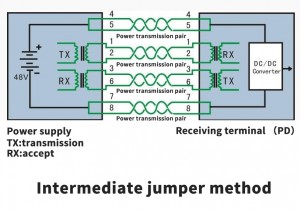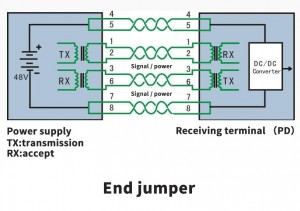1 Introduction
PoE is also called Power over LAN (PoL) or Active Ethernet, sometimes referred to as Power over Ethernet for short. This is the latest standard specification that uses existing standard Ethernet transmission cables to transmit data and power at the same time, and maintains compatibility with existing Ethernet systems and users. The IEEE 802.3af standard is a new standard based on the POE of the Power-over-Ethernet system. It adds related standards for direct power supply through network cables on the basis of IEEE 802.3. It is an extension of the existing Ethernet standard and the first international standard for power distribution. standard.
IEEE began to develop the standard in 1999, and the earliest participating vendors were 3Com, Intel, PowerDsine, Nortel, Mitel, and National Semiconductor. However, the lack of this standard has been restricting the expansion of the market. Until June 2003, the IEEE approved the 802.3af standard, which clearly specified power detection and control items in remote systems, and connected routers, switches, and hubs to IP phones, security systems, and wireless local area networks through Ethernet cables. The power supply method for points and other equipment is regulated. The development of IEEE 802.3af includes the efforts of many company experts, which also allows the standard to be fully tested.
Typical power over Ethernet system. Put the Ethernet switch equipment in the wiring closet, and use a mid-span hub with a power hub to supply power to the twisted pair of the LAN. At the end of the twisted pair, the power supply is used to power phones, wireless access points, cameras, and other devices. To avoid power outages, UPS can be used.
2 principle
The standard Category 5 network cable has four pairs of twisted pairs, but only two of them are used in l0M BASE-T and 100M BASE-T. IEEE80 2.3af allows two usages. When the idle pin is used for power supply, pins 4 and 5 are connected as the positive pole, and pins 7 and 8 are connected as the negative pole.
When the data pin is used for power supply, the DC power supply is added to the midpoint of the transmission transformer, which does not affect the data transmission. In this way, pair 1, 2 and pair 3, 6 can have any polarity.
The standard does not allow the application of the above two conditions at the same time. The power supply equipment PSE can only provide one usage, but the power application equipment PD must be able to adapt to both situations at the same time. The standard stipulates that the power supply is usually 48V, 13W. It is relatively easy for PD equipment to provide 48V to low voltage conversion, but at the same time it should have an insulation safety voltage of 1500V.
3 parameters
A complete POE system includes two parts: power supply equipment (PSE) and power supply equipment (PD). The PSE device is a device that supplies power to the Ethernet client device, and is also the manager of the entire POE Ethernet power supply process. The PD device is a PSE load that accepts power, that is, the client device of the POE system, such as IP phones, network security cameras, APs, and many other Ethernet devices, such as PDAs or mobile phone chargers (in fact, any power does not exceed 13W The device can get the corresponding power from the RJ45 socket). The two are based on the IEEE 802.3af standard and establish a connection through the PD connection, device type, power consumption level and other information of the power receiving device, and on this basis, the PD is powered by the PSE through the Ethernet.
The main power supply characteristic parameters of the POE standard power supply system are:
1. The voltage is between 44V and 57V, with a typical value of 48V.
2. The maximum allowable current is 550mA, and the maximum starting current is 500mA.
3. The typical working current is 10-350mA, and the overload detection current is 350-500mA.
4. Under no-load conditions, the maximum required current is 5mA.
5. Provide three levels of electrical power requirements of 3.84~12.95W for PD equipment, the maximum does not exceed 13W. (Note that PD levels 0 and 4 are not displayed and should not be used.)
4 working process
When arranging PSE power supply terminal equipment in a network, the working process of POE Power over Ethernet is shown below.
1. Detection
At the beginning, the PSE device outputs a very small voltage at the port until it detects that the connection of the cable terminal is a power-receiving device that supports the IEEE 802.3af standard.
2. PD device classification
When the PD of the receiving end device is detected, the PSE device may classify the PD device and evaluate the power loss required by the PD device.
During the startup period of a configurable time (generally less than 15μs), the PSE device starts to supply power to the PD device from a low voltage until it provides a 48V DC power supply.
4. Power supply
Provides a stable and reliable 48V DC power for PD equipment to meet the power consumption of PD equipment that does not exceed 15.4W.
5. Power off
If the PD device is disconnected from the network, the PSE will quickly (usually within 300-400ms) stop powering the PD device, and repeat the detection process to detect whether the terminal of the cable is connected to the PD device.
5 power supply method
The PoE standard defines two methods for using Ethernet transmission cables to transmit DC power to POE-compatible devices:
1.Mid-Span
Use the unused idle wire pairs in the Ethernet cable to transmit DC power. It is used between ordinary switches and network terminal equipment. It can supply power to the network terminal equipment through the network cable. Midspan PSE (mid-span power supply equipment) is a special power management Equipment, usually put together with the switch. It has two RJ45 jacks corresponding to each port, one is connected to the switch with a short cable, and the other is connected to the remote device.
End-Span
The direct current is simultaneously transmitted on the core wire used for data transmission, and its transmission uses a different frequency from the Ethernet data signal. The corresponding Endpoint PSE (terminal power supply equipment) has an Ethernet switch, router, hub or other network switching equipment that supports the POE function. It is foreseeable that End-Span will be promoted quickly. This is because the Ethernet data and power transmission use a common pair, which eliminates the need to set up a dedicated line for independent power transmission. This is for only 8-core cables and the matching standard RJ- The 45 socket is particularly significant.
6 development
PowerDsine, a power-over-Ethernet chip manufacturer, will hold an IEEE meeting to formally submit a “high-power power-over-Ethernet” standard, which will support power supply for laptops and other devices. PowerDsine will submit a white paper, suggesting that the 802.3af standard 48v input and 13w available power limit should be doubled. In addition to notebook computers, the new standard may also power liquid crystal displays and video phones. On October 30, 2009, IEEE issued a newest 802.3at standard, which stipulates that POE can provide higher power, which exceeds 13W and can reach 30W!







